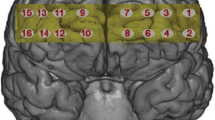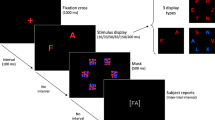Abstract
Rationale
The present study provides the first evidence of the long-term consequences of ecstasy use on visual processes thought to reflect serotonergic functions in the occipital lobe. Methylenedioxymethamphetamine (“ecstasy”) is known to cause lasting changes to the serotonin system in animals, and convergent evidence suggests that similar changes occur in human ecstasy users. Other research suggests that serotonin may be involved in lateral inhibition between orientation sensitive neurons in the occipital lobe, and that disruption to the serotonin system causes an increase in the magnitude of the tilt aftereffect illusion that is known depend on those neurons.
Objectives
The aim of the present study was to determine if ecstasy users have detectable changes in occipital lobe behavioural functioning, as revealed by the tilt aftereffect illusion.
Materials and methods
Thirty ecstasy users and 34 non-drug using controls were compared on the magnitude of the tilt aftereffect illusion following adaptation to stimuli oriented at 15 and 40° from vertical.
Results
Ecstasy users who had not used amphetamines for 115 days or more had a larger average tilt aftereffect than non-drug using controls after adaptation to 40° stimuli but not after adaptation to 15° stimuli. Additionally, there was no difference between non-drug using controls and ecstasy users who had used amphetamines within the last 61 days at either adaptation angle.
Conclusions
The results were consistent with the proposal that ecstasy-related damage to the serotonin system causes behavioural changes on tests of visual perception processes that are thought to reflect serotonergic functions in the occipital lobe.



Similar content being viewed by others
References
Anglin AD, Hser Y, Chou C (1993) Reliability and validity of retrospective behavioural self-report by narcotics addicts. Eval Rev 17(1):91–108
Asgari K, Body S, Rickard JF, Zhang Z, Fone KC, Bradshaw CM et al (2005) Effects of quipazine and m-chlorophenylbiguanide (m-CPBG) on the discrimination of durations: evidence for the involvement of 5-HT2A but not 5-HT3 receptors. Behav Pharmacol 16(1):43–51
Bell C, Abrams J, Nutt D (2001) Tryptophan depletion and its implications for psychiatry. Br J Psychiatry 178:399–405
Buchert R, Thomasius R, Nebeling B, Petersen K, Obrocki J, Jenicke L et al (2003) Long-term effects of “ecstasy” use on serotonin transporters of the brain investigated by PET. J Nucl Med 44(3):375–384
Buchert R, Thomasius R, Wilke F, Petersen K, Nebeling B, Obrocki J et al (2004) A voxel-based PET investigation of the long-term effects of “ecstasy” consumption on brain serotonin transporters. Am J Psychiatry 161(7):1181–1189
Carpenter RH, Blakemore C (1973) Interactions between orientations in human vision. Exp Brain Res 18(3):287–303
Cole JC, Sumnall HR, Grob CS (2002) Sorted: ecstasy. Psychologist 15(9):464–467
Cowan RL, Haga E, Frederick BD, Dietrich MS, Vimal RL, Lukas SE et al (2006) MDMA use is associated with increased spatial BOLD fMRI visual cortex activation in human MDMA users. Pharmacol Biochem Behav 84(2):219–228
Croft RJ, Mackay AJ, Mills AT, Gruzelier JG (2001) The relative contributions of ecstasy and cannabis to cognitive impairment. Psychopharmacology (Berl) 153(3):373–379
Dafters RI, Duffy F, O’Donnell PJ, Bouquet C (1999) Level of use of 3,4-methylenedioxymethamphetamine (MDMA or Ecstasy) in humans correlates with EEG power and coherence. Psychopharmacology 145(1):82–90
Daumann J, Schnitker R, Weidemann J, Schnell K, Thron A, Gouzoulis-Mayfrank E (2003) Neural correlates of working memory in pure and polyvalent ecstasy (MDMA) users. Neuroreport 14(15):1983–1987
Daumann J, Fischermann T, Pilatus U, Thron A, Moeller-Hartmann W, Gouzoulis-Mayfrank E (2004) Proton magnetic resonance spectroscopy in ecstasy (MDMA) users. Neurosci Lett 362(2):113–116
de Win MM, Reneman L, Reitsma JB, den Heeten GJ, Booij J, van den Brink W (2004) Mood disorders and serotonin transporter density in ecstasy users—the influence of long-term abstention, dose, and gender. Psychopharmacology (Berl) 173(3–4):376–382
Derogatis LR (1993) BSI: brief symptom inventory: administration, scoring and procedures manual, 3rd edn. National Computer Systems, Minneapolis, MN
Dughiero G, Schifano F, Forza G (2001) Personality dimensions and psychopathological profiles of Ecstasy users. Hum Psychopharmacol 16(8):635–639
Engel SA, Rumelhart DE, Wandell BA, Lee AT, Glover GH, Chichilnisky EJ et al (1994) fMRI of human visual cortex. Nature 369(6481):525 [erratum in Nature (1994), 1370(6485):1106]
Fantegrossi WE, Ullrich T, Rice KC, Woods JH, Winger G (2002) 3,4-Methylenedioxymethamphetamine (MDMA, “ecstasy”) and its stereoisomers as reinforcers in rhesus monkeys: serotonergic involvement. Psychopharmacology (Berl) 161(4):356–364
Fox HC, Toplis AS, Turner JJ, Parrott AC (2001) Auditory verbal learning in drug-free Ecstasy polydrug users. Hum Psychopharmacol 16(8):613–618
Gamma A, Frei E, Lehmann D, Pascual-Marqui RD, Hell D, Vollenweider FX (2000) Mood state and brain electric activity in Ecstasy users. Neuroreport 11(1):157–162
Gartside SE, Cowen PJ, Sharp T (1992) Evidence that the large neutral amino acid l-valine decreases electrically-evoked release of 5-HT in rat hippocampus in vivo. Psychopharmacology (Berl) 109(1–2):251–253
Gerra G, Zaimovic A, Ampollini R, Giusti F, Delsignore R, Raggi MA et al (2001) Experimentally induced aggressive behavior in subjects with 3,4-methylenedioxy-methamphetamine (“ecstasy”) use history: psychobiological correlates. J Subst Abuse 13(4):471–491
Gescheider GA (1985) Psychophysics: method, theory and application. IEA, London
Gibson JJ, Radner M (1937) Adaptation, after-effect and contrast in the perception of tilted lines. I. Quantitative studies. J Exp Psychol 20:453–467
Green AR, Mechan AO, Elliott JM, O’Shea E, Colado MI (2003) The pharmacology and clinical pharmacology of 3,4-methylenedioxymethamphetamine (MDMA, “ecstasy”). Pharmacol Rev 55(3):463–508
Hanson KL, Luciana M (2004) Neurocognitive function in users of MDMA: the importance of clinically significant patterns of use. Psychol Med 34(2):229–246
Harris JP, Gelbtuch MH, Phillipson OT (1986) Effects of haloperidol and nomifensine on the visual aftereffects of tilt and movement. Psychopharmacology (Berl) 89(2):177–182
Heimer L (1994) The human brain and spinal cord, 2nd edn. Springer, Berlin Heidelberg New York
Hubel DH, Wiesel TN (1970) Stereoscopic vision in macaque monkey. Nature 225:41–42
Hubel DH, Wiesel TN (1974) Uniformity of monkey striate cortex: a parallel relationship between field size, scatter, and magnification factor. J Comp Neurol 158(3):295–305
Klugman A, Hardy S, Baldeweg T, Gruzelier J (1999) Toxic effect of MDMA on brain serotonin neurons. Lancet 353(9160):1269–1270
Lucas SK, Carstairs J, Shores EA (2003) A comparison of methods to estimate premorbid intelligence in an Australian sample: data from the Macquarie University Neuropsychological Normative Study (MUNNS). Aust Psychol 38(3):227–237
Masini R, Antonietti A, Moja EA (1990) An increase in strength of tilt aftereffect associated with tryptophan depletion. Percept Mot Skills 70(2):531–539
McCann UD, Ricaurte GA (2004) Amphetamine neurotoxicity: accomplishments and remaining challenges. Neurosci Biobehav Rev 27(8):821–826
McCann UD, Szabo Z, Seckin E, Rosenblatt P, Mathews WB, Ravert HT et al (2005) Quantitative PET studies of the serotonin transporter in MDMA users and controls using [(11)C]McN5652 and [(11)C]DASB. Neuropsychopharmacology 30:1741–1750
Nichols DE, Oberlender R (1990) Structure-activity relationships of MDMA and related compounds: a new class of psychoactive agents? In: Peroutka SJ (ed) Ecstasy: the clinical pharmacological and neurotoxicological effects of the drug MDMA. Kluwer, Boston
Pagano RR (1998) Understanding statistics in the behavioural sciences. Brooks/Cole, Pacific Grove, CA
Reneman L, Booij J, Schmand B, van den Brink W, Gunning B (2000a) Memory disturbances in “ecstasy” users are correlated with an altered brain serotonin neurotransmission. Psychopharmacology 148(3):322–324
Reneman L, Habraken JBA, Majoie CBL, Booij J, den Heeten GJ (2000b) MDMA (“ecstasy”) and its association with cerebrovascular accidents: preliminary findings. Am J Neuroradiol 21(6):1001–1007
Reneman L, Endert E, de Bruin K, Lavalaye J, Feenstra MG, de Wolff FA et al (2002) The acute and chronic effects of MDMA (“ecstasy”) on cortical 5-HT2A receptors in rat and human brain. Neuropsychopharmacology 26(3):387–396
Ringach DL, Shapley RM, Hawken MJ (2002) Orientation selectivity in macaque V1: diversity and laminar dependence. J Neurosci 22(13):5639–5651
Schiller PH, Finlay BL, Volman SF (1976) Quantitative studies of single-cell properties in monkey striate cortex. II. Orientation specificity and ocular dominance. J Neurophysiol 39(6):1320-1333
Shapley R, Hawken M, Ringach DL (2003) Dynamics of orientation selectivity in the primary visual cortex and the importance of cortical inhibition. Neuron 38(5):689–699
Shulgin AT (1990) History of MDMA. In: Peroutka SJ (ed) Ecstasy: the clinical, pharmological and neurotoxicological effects of the drug MDMA. Kluwer, Boston, pp 1–20
Steele TD, McCann UD, Ricaurte GA (1994) 3,4-Methylenedioxymethamphetamine (MDMA, “ecstasy”): pharmacology and toxicology in animals and humans. Addiction 89:539–551
Terriere D, Janssen PM, Gommeren W, Gysemans M, Mertens JJ, Leysen JE (1995) Evaluation of radioiodo-4-amino-N-[1-[3-(4-fluorophenoxy)-propyl]-4- methyl-4-piperidinyl]-5-iodo-2-methoxybenzamide as a potential 5HT2 receptor tracer for SPE(C)T. Nucl Med Biol 22(8):1005
Thomasius R, Petersen K, Buchert R, Andresen B, Zapletalova P, Wartberg L et al (2003) Mood, cognition and serotonin transporter availability in current and former ecstasy (MDMA) users. Psychopharmacology (Berl) 167(1):85–96
Tootell RB, Hadjikhani NK, Vanduffel W, Liu AK, Mendola JD, Sereno MI et al (1998) Functional analysis of primary visual cortex (V1) in humans. Proc Natl Acad Sci USA 95(3):811–817
Wang X, Baumann MH, Xu H, Rothman RB (2004) 3,4-methylenedioxymethamphetamine (MDMA) administration to rats decreases brain tissue serotonin but not serotonin transporter protein and glial fibrillary acidic protein. Synapse 53(4):240–248
Wang J, Carlson RG, Falck RS, Siegal HA, Rahman A, Li L (2005) Respondent-driven sampling to recruit MDMA users: a methodological assessment. Drug Alcohol Depend 78(2):147–157
Wilson ME, Cragg BG (1967) Projections from the lateral genticulate nucleus in the cat and monkey. J Anat 101:677–692
Zeki S (1978) Uniformity and diversity of structure and function in rhesus monkey prestriate visual cortex. J Physiol 277:273–290
Zuckerman M (1994) Behavioral expressions and biosocial bases of sensation seeking. Cambridge University Press, Cambridge
Acknowledgement
This study was aided by a grant to E.M. from the Faculties Research Grant Scheme of The Australian National University. J.B. was supported for part of the research by an Australian postgraduate award (APA). The experiments complied with the current laws of the country in which they were performed.
Author information
Authors and Affiliations
Corresponding author
Additional information
An erratum to this article can be found at http://dx.doi.org/10.1007/s00213-007-0854-4
Rights and permissions
About this article
Cite this article
Brown, J., Edwards, M., McKone, E. et al. A long-term ecstasy-related change in visual perception. Psychopharmacology 193, 437–446 (2007). https://doi.org/10.1007/s00213-007-0785-0
Received:
Accepted:
Published:
Issue Date:
DOI: https://doi.org/10.1007/s00213-007-0785-0




